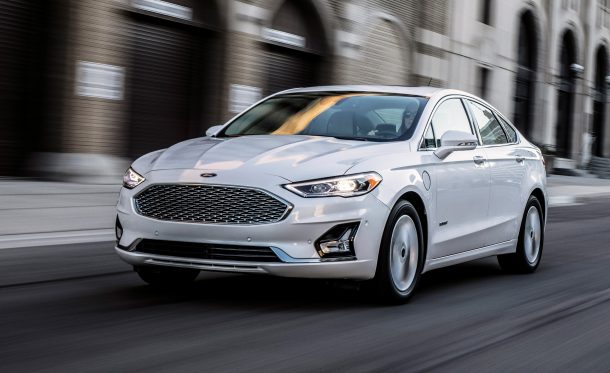For What It's Worth, You'll Be Able to Get Your Hands on a 2020 Ford Fusion

Stop the presses. Ford’s Fusion sedan, a member of the passenger car crowd Ford sentenced to death last year, will at least outlive its non-Mustang stablemates.
While American-market Focus and C-Max production has already dried up, followed soon by the Taurus and Fiesta, Ford was never clear on when exactly the Fusion midsizer would bite the dust. The exact date of its impending death remains a mystery, but there’s now assurances from Ford that Fusions will continue rolling into dealers until at least the 2020 model year.
After seeing production data for a 2020 Fusion, CarsDirect sought confirmation from Ford. Company spokesperson Sam Schembari replied in the affirmative. Yes, there’ll still be Fusions on shopping lists for the 2019 and 2020 model years.
Whether Ford builds a run of 2021 models — the target year for Ford’s car cull completion — remains to be seen.
CarsDirect notes consumers still have access to healthy incentives on remaining Focus models, as well as the Fiesta (the only Ford car model to end 2018 with a sales increase). For midsize shoppers, the site points out that lease deals on 2019 Fusion hybrid models are far more attractive than that of their cheaper, gas-only counterparts, which isn’t news to Adam Tonge, who spent no shortage of time scanning Detroit-area Fusion Hybrid ads the other night. The Midwest seems to be brimming with cheap Fusion Hybrids.
Assuming you’re in the market for a mainstream sedan, it’s worth noting that all 2019 Fusions come with the automaker’s Co-Pilot360 suite of driver assist features as standard equipment. Second-from-base SE models ditch the old 2.5-liter in favor of a turbocharged 1.5-liter, while Energi plug-in variants extend their electric driving range by 4 miles.
Unlike its passenger car stablemates, the Fusion’s two hybrid variants deliver green cred that should hold the company over until new hybrids and EVs come online starting in 2020. It’s also possible that, after that date, the Fusion name won’t fade away. Rumors exist of the nameplate affixing itself to a crossover-like vehicle aimed at Ford car faithful — rumors Ford hasn’t exactly denied.
Despite the ongoing collapse of the country’s passenger car market, the Fusion remains the best-selling car nameplate in Ford’s stable. Its 173,600 U.S. sales in 2018 represent a 17.2 percent decline from a year prior.
[Images: Ford]

More by Steph Willems
Latest Car Reviews
Read moreLatest Product Reviews
Read moreRecent Comments
- Lorenzo This car would have sold better if there was a kit to put fiberglass toast slices on the roof.
- Lorenzo The Malibu is close to what the 1955 Bel Air was, but 6 inches shorter in height, and 3 inches shorter in wheelbase, the former making it much more difficult to get into or out of. Grandma has to sit in front (groan) and she'll still have trouble getting in and out.The '55s had long options lists, but didn't include a 91 cubic inch four with a turbo, or a continuously variable transmission. Metal and decent fabric were replaced by cheap plastic too. The 1955 price was $1765 base, or $20,600 adjusted for inflation, but could be optioned up to $3,000 +/-, or $36,000, so in the same ballpark.The fuel economy, handling, and reliability are improved, but that's about it. Other than the fact that it means one fewer sedan available, there's no reason to be sorry it's being discontinued. Put the 1955 body on it and it'll sell like hotcakes, though.
- Calrson Fan We are already seeing multiple manufacturers steering away from EVs to Hybrids & PHEVs. Suspect the market will follow. Battery tech isn't anywhere close to where it needs to be for EV's to replace ICE's. Neither is the electrical grid or charging infrastructure. PHEV's still have the drawback that if you can't charge at home your not a potential customer. I've heard stories of people with Volts that never charge them but that's a unique kind of stupidity. If you can't or don't want to charge your PHEV then just get a hybrid.
- AZFelix The last time I missed the Malibu was when one swerved into my lane and I had to brake hard to avoid a collision. 1 out of 5⭐️. Do not recommend.
- 2ACL I won't miss it; it was decent at launch, but in addition to the bad packaging, GM did little to keep it relevant in the segment. I'd prefer that another domestic automaker doesn't just give up on the mainstream sedan, but unlike some of Ford's swan songs, the Malibu made an indifferent case for why they should live.


































Comments
Join the conversation
I kissed a Fusion and I liked it. Actually, I rented one during a week-long trip to Tampa at the end of December. I wasn't at all sure what to expect, but as it turned out I really liked the car. I found it a pleasant alternative to the "meh" styling that I feel characterizes the other cars in its class. I found myself thinking what a shame it was that Ford was going to stop making them and that I would be unable to buy one in a year or two when I'll be in the market for a new vehicle. This is the best automotive news to come my way in a while. I sincerely hope that the Fusion continues to live beyond 2020.
I have noticed something strange about 2019 Fusions. So far each and every one has been a hybrid SE and nothing else. No base or SE gas models. No Sports no SEL. Is there a delay on the non hybrid 2019 Fusions?